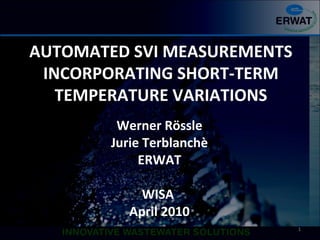
presentation wisa 2010 15 April 2010 2
- 1. AUTOMATED SVI MEASUREMENTS INCORPORATING SHORT-TERM TEMPERATURE VARIATIONS Werner Rössle Jurie Terblanchè ERWAT WISA April 2010 1
- 2. CONTENT • Background • Experimental • Results – Batch tests conventional SVI – On-line tests automated on-line SVI monitoring at full- scale reactor – Modelling SVI combined with both MLSS concentration and sample temperature from on-line data • Conclusions • Project summary • Acknowledgements 2
- 3. BACKGROUND Sludge Volume Index (SVI) test • Developed 1934, procedure simple, fast, widely used, data • SVI of < 100 to 150 ml/g indicates a well-settling sludge • Temperature dependency generally not considered, and compensation methods usually not implemented Standard methods (APHA, 1998) SVI test procedure • Sample of known MLSS concentration, 1 litre cylinder, stirred, 30 minute settling • Settled sludge volume read off cylinder wall • SVI = settled sludge volume (ml/l) / MLSS concentration (g/l) • Sample temperature kept constant at reactor (basin) temperature during SVI settling test – no procedure provided 3
- 4. EXPERIMENTAL(1) BATCH TEST Basic sludge settling test in cylinders 4
- 5. EXPERIMENTAL(2) BATCH TEST SVI test method • reactor and ambient temperatures • MLSS concentration • reactor sludge sample, remix • sludge in 1 or 2 litre cylinder(s), remix • cylinder in shade or sunshine (assess location) • sample temperature • start sludge settling test immediately • 30 minutes settling to obtain settled volume • sample temperature again (probe of thermometer in same position inside cylinder during all measurements) • calculate SVI 5
- 6. EXPERIMENTAL(3) ON-LINE METER 6 • Settler• Settler
- 7. EXPERIMENTAL(4) ON-LINE METER Automated on-line SVI meter – Mobile (220V and water supply) in an enclosure – 2 ℓ Perspex settling cylinder (84.0 mm diameter and 360.9 mm height), removable for cleaning – On-line Tr, Tc, Ta, MLSS concentration – Moving infrared light scanner – 6-line graphic recorder, data storage, retrieval – Automated sample filling, settling, draining, and washing stages – Sludge sample transfer vacuum based, no mechanical pumping 7
- 8. RESULTS(1) BATCH TEST Cylinder Place MLSS conc. [mg/l] Tr [°C] Ta [°C] 5830 20.5 30.1 5870 20.8 31.5 Average 1 ℓ Shade SVI[ml/g] 118 107 113 Tc30 [°C ] 25.3 24.4 24.9 1 ℓ Sun SVI[ml/g] 89 80 85 Tc30 [°C ] 26.2 27.9 27.1 2 ℓ Shade SVI[ml/g] 130 126 128 Tc30 [°C ] 24.3 23.3 23.8 2 ℓ Sun SVI[ml/g] 93 82 88 Tc30 [°C ] 25.6 26.6 26.1 8
- 9. RESULTS(2) BATCH TEST ILLUSTRATION 9 START OF SETTLING TEST 1, 15/10 MLSS = 5830 mg/l Tr = 20.5°C Ta = 30.1°C Tc = 20.6°C Samples in sun or shade - change Tc END OF SETTLING TEST: Sample handling: 1l sun, 1l shade, 2l shade, 2l sun Sample temperature Tc30 26.2, 25.3, 25.6, 24.3 4 SVI from one reactor sample: 89,118, 130, 93 89 118 130 93
- 10. RESULTS(3) BATCH TEST ILLUSTRATION 10 START OF SETTLING TEST 2, 16/10 MLSS = 5870 mg/l Tr = 20.8°C Ta = 31.5°C Tc = about 22°C Samples in sun or shade - change Tc END OF SETTLING TEST: Sample handling: 2l sun, 1l sun, 2l shade, 1l shade Sample temperature Tc30 26.6, 27.9, 23.3, 24.4 4 SVI from one reactor sample: 82, 80, 126, 107 82 80 126 107
- 11. RESULTS(4) DIURNAL ON-LINE SVI 11 Graph of 44 on-line 30-minute settling curves, MLSS concentration, temperature and calculated SVI trends over a diurnal period
- 12. RESULTS(5) SETTLING CURVES & SVI 12 Graph of 2 on-line 30-minute settling curves, MLSS concentration, temperature and calculated SVI trends
- 13. RESULTS(6) SVI vs. MLSS CONC. 13 Data scatter, R2 = 0.47
- 14. RESULTS(7) SVI vs. TEMPERATURE 14 Data scatter, R2 = 0.69
- 15. RESULTS(8) SVI vs. MLSS CONC. & TEMP. 15 R2 = 0.84
- 16. RESULTS(9) BASIC MODEL • Commercial statistical software package • Basic regression model for easy use: • R2 improvement about 0.3 with one case study • Significant parameters affecting SVI: – MLSS concentration – Sample temperature • 8 ml/g SVI change (average) per 1°C on-line sample temperature change with one case study 16
- 17. CONCLUSIONS 1. Batch settling test: substantial temperature change – Test cylinder environment has an influence on sample temperature and SVI 1. On-line settling test: automated diurnal trends – Short time delay between sampling and test reduces sample temperature variations, improved SVI – Incorporates reactor temperature variations in SVI trend 1. Modelling: correlations for general and design use – Improved SVI correlations with both temperature and MLSS concentration 17
- 18. PROJECT SUMMARY • Include temperature in sludge settling analysis – reactor, ambient, sample temperatures, or at least stabilised sample and room temperatures • Use a consistent reference basis of experimental conditions is a basic requirement – impact of cylinder handling and temperature on results used for plant process control or design or modelling • Do not extrapolate any results from a case study – develop correlations for each plant or reactor • On-line automated sludge settling monitoring – benefits relate to automated sampling and testing methods and on-line data generation 18
- 19. ACKNOWLEDGEMENTS • ERWAT provided facilities and research resources • ERWAT Research and Development Forum, Board of Directors and Executive Management provided support • ERWAT operational personnel assisted during batch settling tests • Mr G. George made key contributions during the development, construction and upgrading of the on-line SVI meter • WRC provided initial project finance on a related activated sludge settling project 19
- 20. Thank you 20
